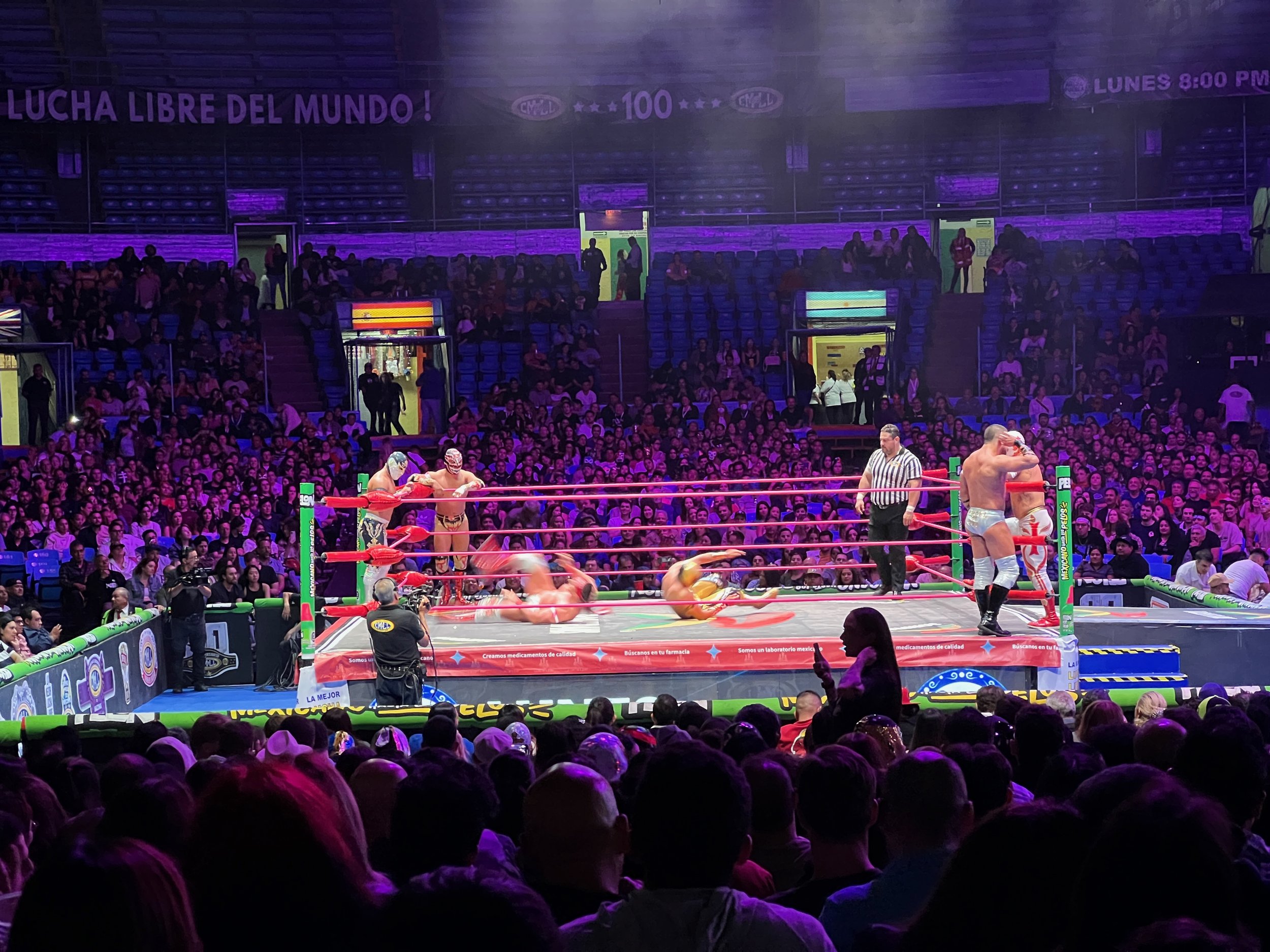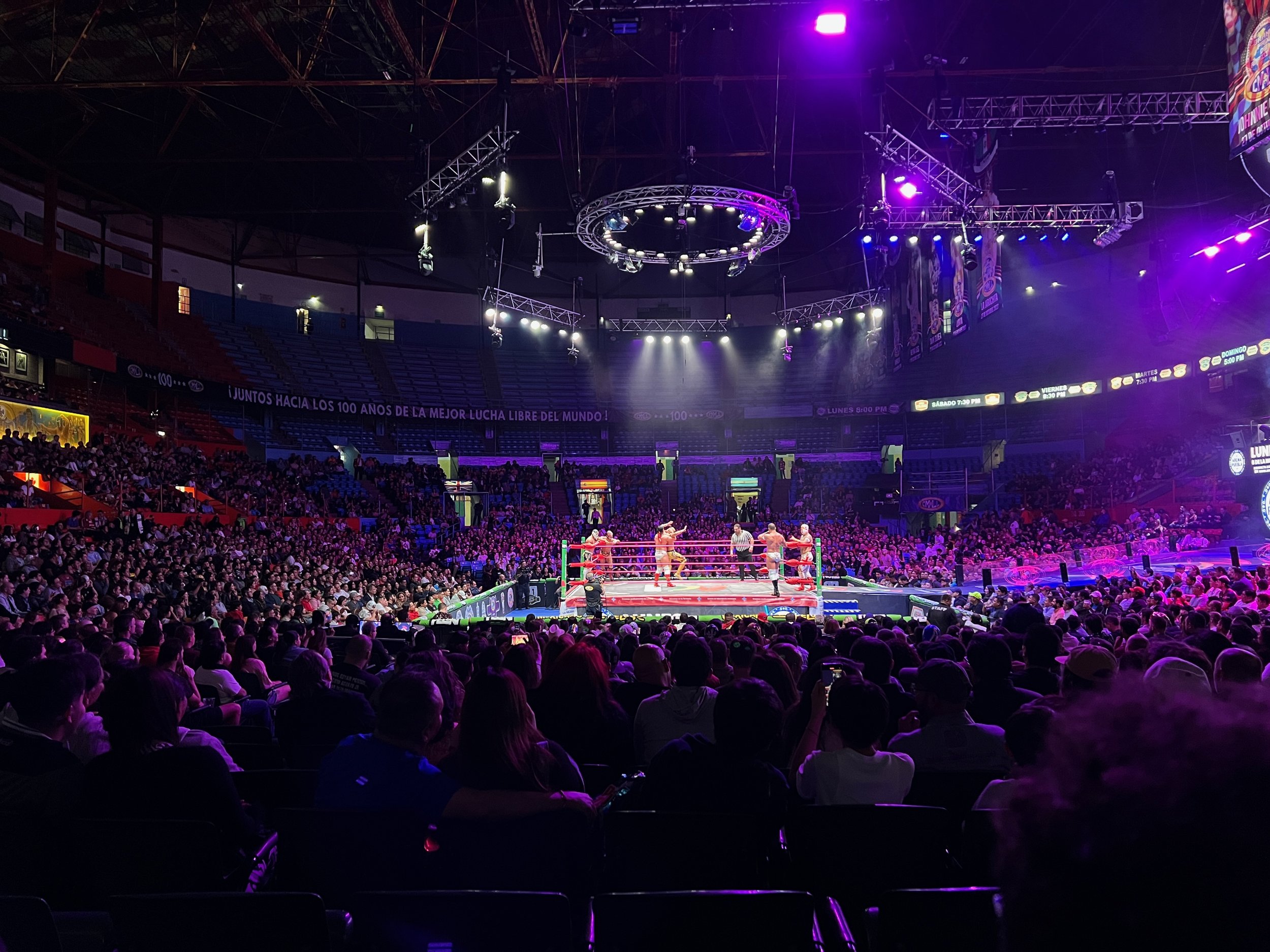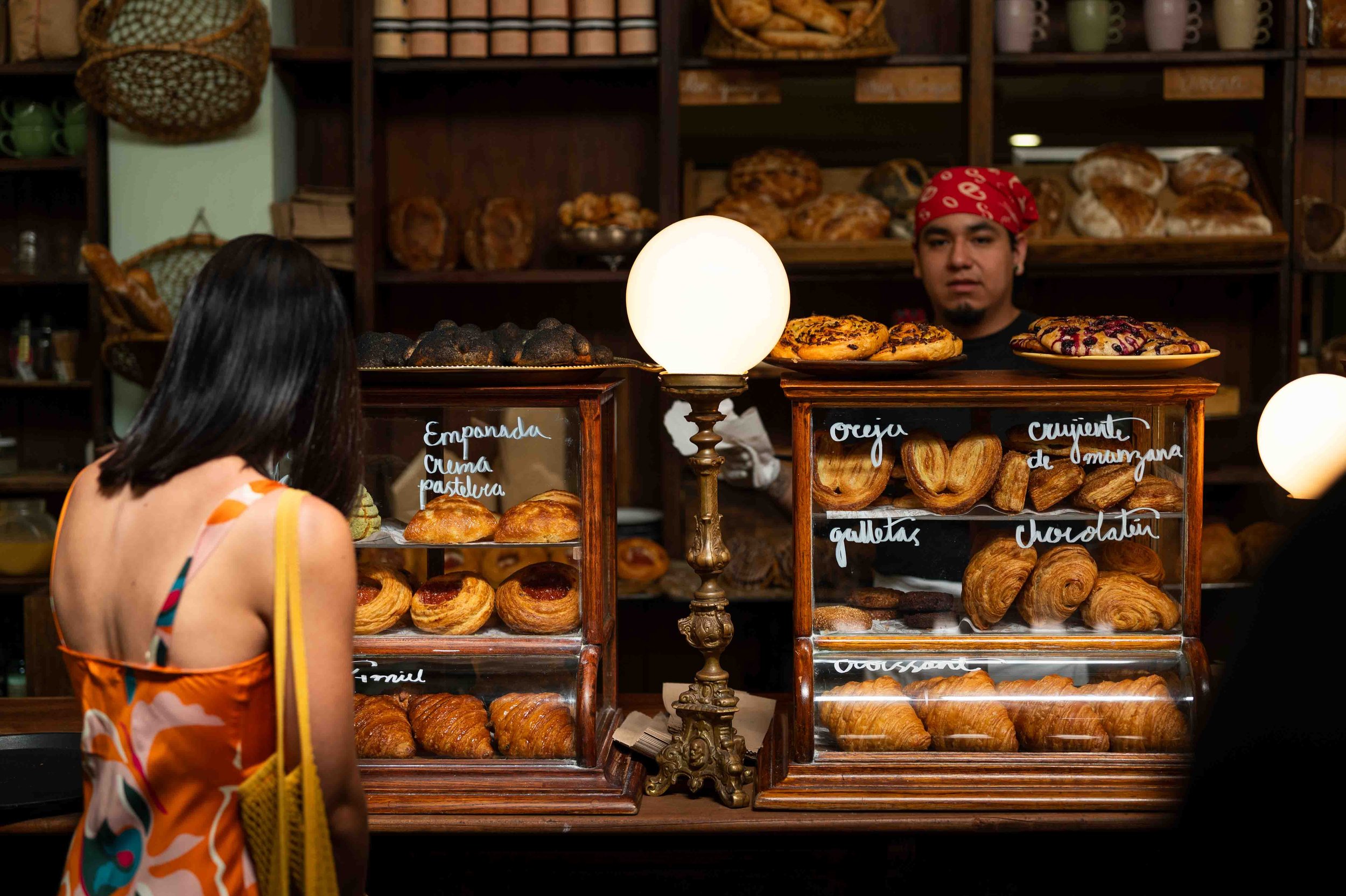Your complete guide to watching the Lucha Libre wrestling in Mexico City
Updated 11th March 2025
If you are, or ever were, a wrestling fan and you find yourself in Mexico City, you must spend an evening watching Lucha Libre. Imagine witnessing several Rey Mysterios in action, it’s an experience that will surely bring out your inner child!
Lucha Libre, which translates to 'freestyle fighting,' is one of Mexico’s most cherished traditions. This adrenaline-pumping form of wrestling is not just a sport but a cultural spectacle, featuring masked wrestlers (luchadores) performing acrobatic moves and engaging in captivating storylines.
We absolutely loved watching Lucha Libre in Mexico City and think it's a fantastic way to spend an evening.
Quick Links
A 3 vs 3 fight at Arena Mexico
Why Lucha Libre is a Must-See in Mexico
Lucha Libre has a rich history in Mexico, dating back to the early 20th century. It has become an iconic part of Mexican culture, much like mariachi music and Día de los Muertos. The colourful masks, flamboyant costumes, and theatrical performances make it a true spectacle.
How to Experience Lucha Libre in Mexico City
There are two main ways to experience Lucha Libre in Mexico City:
Independently by booking your own tickets
Booking onto one of many tours available.
Lucha Libre Tours
Usually, we like to arrange things ourselves, but for this, we decided to book a tour, mainly to meet more people in CDMX, and having a local guide would give us more context about what was happening.
Here’s how our tour went:
Tacos: The evening started with a visit to a local taqueria (Los Huarachines) in Roma Norte that specialises in Tacos El Pastor. We got introduced to the other people in our group and got to chat over those delicious tacos. (There were about 14 of us)
Mezcal Bar: Next, we went to a mezcal bar for a tasting. Here, the tour guides gave us a few mezcals to try whilst explaining the history of Lucha Libre. They gave us some background knowledge about the wrestlers and the matches we were expecting to watch that night; as well as explaining the chants we were likely to hear. At the time, this seemed a bit cheesy, but we later realised that that’s the point of Lucha Libre. We were given some Lucha Libre wrestling masks to wear for the evening and take home as souvenirs.
The Fight: After the Mezcal, we headed to Arena Mexico to watch the Lucha Libre matches. We arrived in time for the last ‘Stellar’ fights. The guides said the first few fights on the card are amateurs, and their feedback from previous tours was that if you go for the whole time, it can drag on.
The fights finished at around 11 pm. We walked back together to Roma Norte, where our tour ended at the same time as the earthquake sirens went off! Luckily, no earthquake followed.
We strongly suggest doing a tour. It will cost more money than organising things yourself, but you’ll get to meet people and have a great time without worrying about logistics.
Also, getting info about what’s going on makes the evening and fights much more enjoyable.
Tacos el Pastor - Los Huarachines
The masks we received during our tour
Getting tickets for Lucha Libre yourself
If you prefer to explore alone, you can buy tickets at the venue before the fights or online. Make sure you arrive early to get good seats and soak in the pre-match atmosphere, or buy your tickets a few days before.
You can buy tickets in advance via Ticketmaster or at the venue. Tickets cost 100 to 700 pesos (£4 - £30 or $5 - $35), with ringside seats being the most expensive.
If you buy tickets online you will pay a bit more due to service charges.
When you check for tickets online, you’ll notice that a few days before, it seems like there will be plenty of ringside seats available, but they get booked up quickly on the day, so don’t leave it too late.
Lucha Libre ticket prices
The price of your ticket varies depending on when you book and which seats you choose. Below are the prices for a Friday night show booked one week in advance on Ticketmaster.
Ring side seats MX$488 - MX$671 (£20-£30)($24 - $32)
Outter floor seats MX$366 (£16)($18)
Upper stands MX$91.50 (£4)($5)
If you book a tour, you can expect to pay between £60 ($75) and £100 ($125) for your ringside ticket, but remember most tours include food, drinks and a guide.
Lucha Libre Schedule
There are two venues where Lucha Libre takes place in CDMX:
Arena México: Known as the “Cathedral of Lucha Libre,” it’s the main venue with a capacity of 13,700. Located in the Colonia Doctores neighbourhood, it hosts shows on Tuesdays, Fridays, and Sundays.
Arena Coliseo: This older and more intimate venue, located in the Historic District, has seating for 6,863 guests and hosts Saturday night matches.
The Friday show at Arena Mexico is the biggest show of the week, with the best fighters on the card.
Tuesdays: 7:30 PM at Arena México
Fridays: 8:30 PM at Arena México
Saturdays: 7:30 PM at Arena Coliseo
Sundays: 5:00 PM at Arena México (family show)
Individual matches last around 10-20 minutes (there is no set time), and the evening shows finish at around 10:30 - 11:00 pm.
Important Tips for Visiting
The following is more relevant to Arena Mexico as that is where we went on our trip:
Travel Safely: We were informed the area around Arena Mexico (Doctores) can be sketchy at night. Always take a cab or use a ride-sharing service directly to and from the venue. There are several bars around Arena Mexico after the fight, but we were strongly advised by many people not to go there or to explore that neighbourhood after dark. After the fight, we walked back to Roma Norte (one of the safest areas of CDMX) and then went to a mezcal bar with some people from our tour group.
No Cameras: Arena Mexico doesn’t allow any cameras inside, so leave them at home and use your phone. You can take videos on your phone, but if you have it recording for too long (over 20 seconds), they will come over and stop you.
No food or drinks: You can’t bring any food or drink inside Arena Mexico, but there is plenty to buy once you get in. You can either go to stalls or there are vendors that bring food and drink to your seats (remember to tip them).
Bring cash: The vendors in the stadium do not take card so bring cash for food and drinks
Bring a layer: The air conditioning is blasting in the Arena so it can get a bit cold.
Avoid the Doctores neighbourhood at night time, head back to Roma Norte after the matches
Lucha Libre: Explained
The Origins of Lucha Libre
Lucha Libre began in the early 20th century, with its modern form taking shape in the 1930s when Salvador Lutteroth González founded the Empresa Mexicana de Lucha Libre (EMLL), now known as Consejo Mundial de Lucha Libre (CMLL), the oldest professional wrestling promotion still in existence.
It outdates the WWE, WWF and WCW.
The matches generally last about three hours and are filled with high-flying moves, dramatic battles and much audience participation. To get a sense of the excitement, check out the official YouTube channel of CMLL.
Key Elements of Lucha Libre
Técnicos vs. Rudos: Lucha Libre matches typically feature a battle between the "técnicos" (good guys) and "rudos" (bad guys). This dynamic creates clear moral stories that are easy to follow, even for those unfamiliar with the sport. Técnicos are known for their acrobatic and technically proficient wrestling styles, while rudos often use underhanded tactics to win.
High-Flying Moves: The style of wrestling in Lucha Libre is distinct for its high-flying maneuvers and acrobatics. Moves like the "plancha" (diving crossbody), "hurricanrana" (headscissors takedown), and "tope suicida" (suicide dive) are common and add to the spectacle.
Luchador Masks
The Luchador Masks or ‘máscara’ in Spanish, are perhaps the most iconic aspect of Lucha Libre. They are not just a means of anonymity but carry deep cultural significance. Wrestlers, or "luchadores," often wear masks to portray characters inspired by mythology, animals, and historical figures. The mask symbolises the wrestler’s identity and losing it in a match is considered a significant dishonour.
Theatricality and Storytelling
Lucha Libre is as much about the stories as it is about the matches. Each luchador’s persona, often tied to their mask, is part of a larger narrative that unfolds over weeks, months, or even years. Storylines can include family legacies, betrayals, and rivalries that captivate the audience. This blend of sport and drama makes each match an engaging experience.
Cultural Significance
Lucha Libre holds a special place in Mexican culture. It reached its peak popularity in the mid-20th century and has remained an important part of the cultural landscape. Luchadores like El Santo and Blue Demon became national heroes, transcending the wrestling ring to appear in films and comics. El Santo, in particular, is a legendary figure, renowned for his silver mask and heroic persona. His career spanned five decades, and he is still celebrated today.
Mistico
Mistico is a major figure in contemporary Lucha Libre and one of the biggest wrestlers today, renowned for his high-flying acrobatics and charismatic persona. Born Luis Ignacio Urive Alvirde, Mistico gained fame in the early 2000s with Consejo Mundial de Lucha Libre (CMLL), quickly becoming one of the promotion's top stars.
His elaborate, angelic mask and innovative moves, such as the "La Mistica" submission hold, made him a fan favourite. After a failed stint in WWE as Sin Cara, Mistico returned to Mexico, where he reclaimed his name and continued to dazzle audiences with his electrifying performances.
Conclusion
Whether you go independently or on a tour, make sure to book a Lucha Libre match in Mexico City for an unforgettable experience.
From the electrifying atmosphere to the rich cultural significance, it offers a true taste of Mexican culture and entertainment. Don't forget to bring some cash, buy a mask, and get ready to cheer for your favourite luchador!
















Everything you need to know on getting to Oaxaca from Mexico City